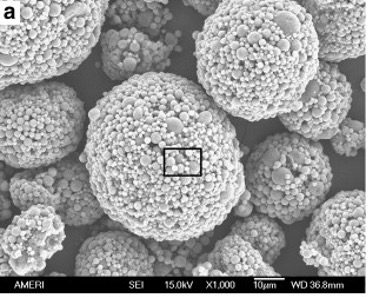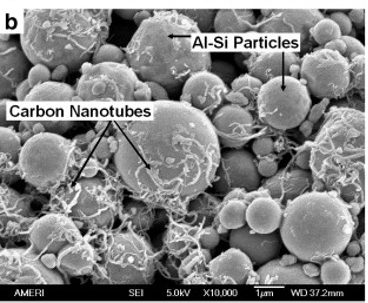Powder Engineering Laboratory
The Powder Engineering Lab serves as a cornerstone in the realm of additive manufacturing and thermal spray techniques, exerting a significant influence on the microstructure and mechanical properties of final parts. The efficacy of these techniques hinges on their capacity to impart powders with precisely tailored intrinsic microstructures, crucial for alloy development and the integration of diverse secondary 1D and 2D nanomaterials to make advanced composite powders. ColRAD primarily harnesses the capabilities of spray dryers, high-energy ball mills, and cryomills to achieve these objectives.
Tools
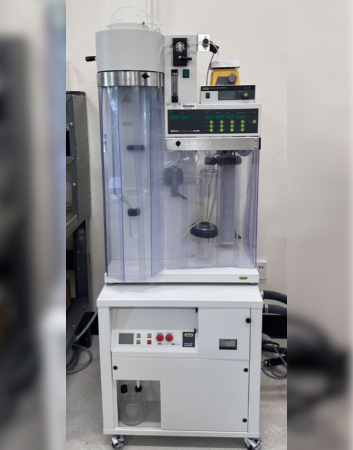
Spray Dryer
Spray drying is an innovative and efficient powder processing technique widely employed to produce agglomerates of fine powders with tailored properties and morphologies. The advanced Spray Dryer BUCHI B290 uses a high-velocity hot gas flow, which facilitates the rapid evaporation of solvent or water content from the atomized droplets and subsequent binding of fine powders into agglomerates. Researchers at ColRAD have adapted this technology to incorporate 2D materials into metal powders, resulting in the production of composites. These composite powders serve as feedstocks for processes like Cold Spray Additive Manufacturing and Plasma Spray.
Features/Specifications:
Evaporation Capacity: 1.0L/h H20,
Higher for Organic Solvents Max Intel Temperature: 220 °C
Max Airflow: 25 m^3/h
Nozzle Type: Two Fluid Nozzle, Three Fluid Nozzle, Ultrasonic Nozzle
Spray Gas: Compressed Air or Nitrogen
Operation Type: Open, Inert Loop Final Particle
Size: 1 to 60 µm
Yield: Up to 70%
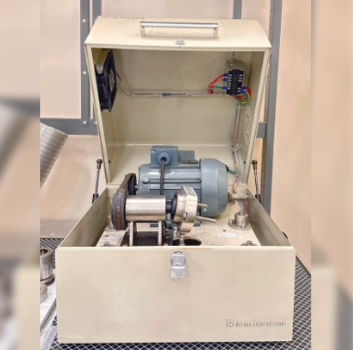
High Energy Vibratory Ball Mill
High-energy ball milling is a mechanical process that involves the use of a ball mill to induce reactions in a powder mixture. In this method, the high-energy collisions between the balls and the powder result in the reduction of particle size, mixing of different components, and, in some cases, the formation of new compounds or alloys.
Features/Specifications:
Oscillation Speed: 1200 rpm
Jar Capacity: 80 ml
Timing Range: 1 to 999 sec
Final Particle Fineness: Down to 0.1 µm
Jar Material: WC
Ball: Alumina, WC, Stainless Steel
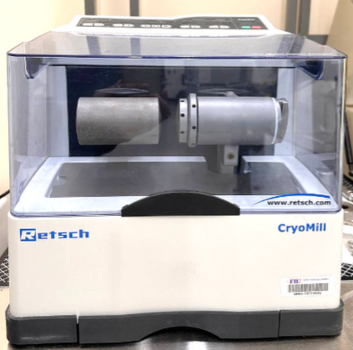
Cyro-Mill
This method involves milling materials at extremely low temperature (often below -150°C), thus it is suitable for handling temperature-sensitive materials or achieving specific properties in the milled products. This technique has been applied to produce ultra-fine ceramics and metal powders with uniform particle size distribution.
Features/Specifications:
Oscillation Speed: 300 to 1800 rpm
Operation Mode: Dry, Wet & Cryogenic Grinding
Cooling Gas: Liquid Nitrogen
Jar Capacity: 50 ml
Timing Range: 10 sec to 99 min
Jar Material: Zirconia Ball Material: Hardened Steel, Stainless Steel, Zirconia
Final Particle Fineness: Down to 5 µm
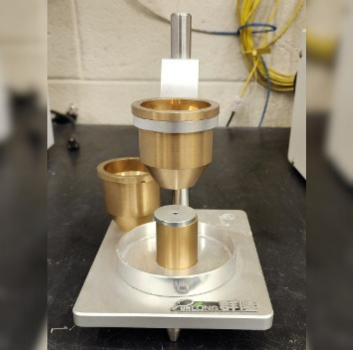
Hall-Flow Meter
Hall Flowmeter funnel, is the preferred method for determining the flowability of metal powders and powder mixtures. A weighed mass (50.0 g) of metal powder is timed as it flows through the calibrated orifice of a Hall Flowmeter funnel according to ASTM B213. A stopwatch or other suitable device capable of measuring to the nearest 0.1 s, is used to time the powder flowability. PFL uses this flow device to analyze the powder flowability of different materials systems before thermal and cold spray operations to optimize the flow properties of powder.
Features/Specifications:
Funnel angle: 60°
Funnel outlet diameter: 2.5 and 5mm
Measuring cup material: Brass
Measuring cup volume: 25 c㎥, 50 c㎥
Measuring cup inner diameter: 30mm
Weight: 3.5Kg
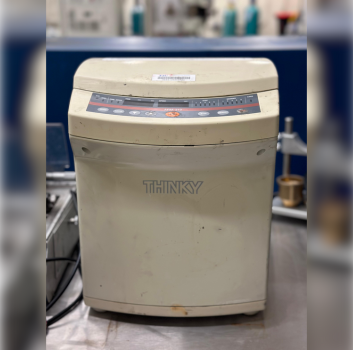
Thinky Mixer
ColRAD use this planetary centrifugal mixer to mix and disperse composite powders, 2D materials, and nanoparticles effectively into material systems. This advanced mixing and deaeration system offers comprehensive support for a wide range of materials, including high-viscosity substances and nanofillers. It incorporates two efficient modes for mixing and deaeration, ensuring rapid dispersion and air bubble removal in high-viscosity materials. The system’s coldinsulated, heat-resistant adapter caters to diverse material characteristics, while its array of adapters accommodates different container types. Memory and step-operation functions provide precise control over operating conditions, enhancing consistency and repeatability. A unique air-cooling system prevents overheating during processing. With a centrifugal force exceeding 400G, this system enables simultaneous mixing, dispersion, and deaeration across viscosities, making it ideal for various powder engineering applications.
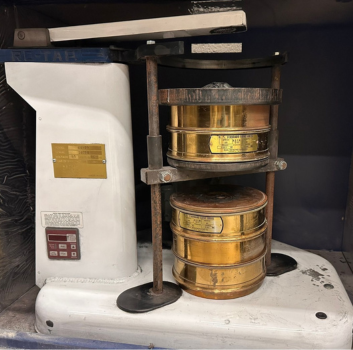
Vibrating Powder Sieving System
The vibrating powder sieving system is a highly efficient and versatile equipment designed for the precise separation and classification of powdered materials based on particle size. This system utilizes vibration mechanisms to evenly distribute particles across the sieve surface, facilitating rapid and thorough screening processes. The vibrations help to prevent clogging and ensure consistent flow of the powder through the mesh or screen, resulting in accurate and reliable sieving outcomes. The circular and tapping motion produced by the RX29 assures accurate and uniform test results not obtainable in hand testing. Built for handling 6 standard 8″ diameter x2″deep test sieves and will accommodate 13 1″deep sieves. The system also includes 30-minute automatic timer and comes with 1/4 HP motor. With adjustable settings for vibration intensity and duration, users can customize the sieving process according to specific material properties and desired particle size distributions. Sieves with particle sizes D90= 20 µm to 100 µm with a step size of 10 µm are employed to sieve and obtain powders with desired particle size distribution
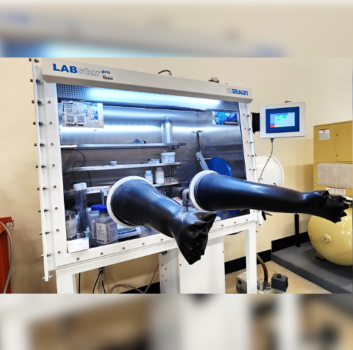
M-Braun Labstar Glove Box
PFL and ColRAD Labs provides a reliable and efficient solution for storing powder materials in a controlled inert environment, meeting the highest standards of quality and functionality for laboratory applications. Key features of this system include a spacious main antechamber, a reliable rotary vane vacuum pump, and the advanced MBRAUN programmable logic controller (PLC) for seamless operation for controlling humidity and oxygen. The single-column inert gas purification system uses a fully automatic and regenerable system, ensuring the glovebox atmosphere is purified to less than 1 ppm of oxygen and moisture. The system supports both Argon and Nitrogen gases as working gases, offering flexibility based on your requirements. Constructed with full stainless-steel piping, the system ensures durability and long-term performance. Its modular enclosure allows for easy expansion and customization, making it adaptable to evolving research needs. The ColRAD utilizes this glove box system extensively to store metallic, ceramic and composite powders to a purity <0.5 ppm in moisture and oxygen to keep the powders in pristine condition before operations such as thermal spray, cold spray, 3D printing, and sintering.
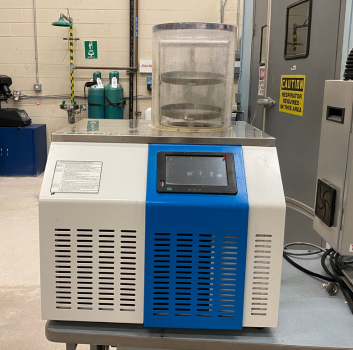
Pro-Lab Diagnostics PLT300 Freeze-Dryer
The Pro-Lab freeze dryer can reach temperatures as low as -56°C and reduce pressures to as low as 1 Pa. The PLT300 freeze dryer is a laboratory instrument designed for lyophilizing samples with high reliability and efficiency. This freeze dryer removes moisture through sublimation under vacuum conditions. The PLT300 has a water capture capacity of 3 kg/24 hr and a loading capacity of 1200 mL, which allows for high sample throughput. Freeze-drying is a technique that can overcome agglomeration challenges in nanomaterial-polymer composites. Freeze-drying assembles nanomaterials into rigid, free-standing, three-dimensional (3D) architectures or foams. Pores in these free-standing foams can be infiltrated with polymers to form nanocomposites with tailorable properties. The Freeze-Drying process allows the design of the foam with tailored pore size, morphology, and orientation by engineering the processing parameters.
Ongoing Research Projects
Integrating 1D and 2D Nanomaterials into Metals and Polymers at ColRAD
At ColRAD, a primary research focus involves developing custom-made powders that integrate 1D and 2D nanomaterials, like carbon nanotubes and hexagonal boron nitride nanotubes, into metals and polymers. This innovative approach enhances mechanical properties and imbues multifunctional capabilities into resulting materials. These nanocomposite powders are utilized for producing coatings and deposits through methods such as cold spray, plasma spray, and spark plasma sintering. The images below illustrates spray-dried Al-Si and carbon nanotube powder used for cold spray deposition.
